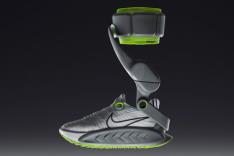
I've been doing triathlons for over 15 years and was an early adopter of the Garmin multisport watches that debuted in the mid-2000s. Hello, Forerunner 205! I've stuck with Garmin’s line ever since; in fact, my current model is the 920XT, which is packed with fun and useful still multisport features.
The Garmin Forerunner 645 Music, however, is my first foray into the running-specific line and, I have to admit, it feels great wearing a fitness watch that doesn't look like a small desktop computer on my petite wrist! The soft wristband has plenty of notches, and it’s easy to adjust to make it looser or more snug, depending on preference.
Initial Thoughts
My first few days with the 645 Music were very similar to the experience of buying a new car and not knowing where everything is just yet. It certainly has all the bells and whistles, but it takes a few days to feel comfortable once you get beyond the initial test drive. Charging and set-up are simple enough, and done via USB and a quick sync with Garmin Connect. Because I wanted to familiarize myself with the watch as quickly as possible, I carried the instruction booklet around with me for a few days until the buttons and features started to become second nature.
Simply put, the watch made me want to keep moving even outside of my usual training sessions.
When turning on the watch, the first thing you can customize is the actual watch face. I had a fun time personalizing everything from accent colors to settings to data displays. For now, I've settled on viewing the time, date, battery life and amount of steps I take in a day (you can also download more watch faces and apps from Garmin’s Connect IQ store.)
Various functions and widgets are pre-programmed, including heart rate, steps, calorie burn and other informative data for both the recreational and serious fitness enthusiast. I've never fancied myself a step-counter, but the moment I programmed it on the front of my watch face, it became a real motivator. The same is true for total calorie burn. Throughout the course of the day, I found myself wanting to continue to best my previous efforts. Simply put, the watch made me want to keep moving even outside of my usual training sessions.
Activity Tracking
Speaking of training, this isn't a traditional multisport watch, meaning there is no specific “triathlon” activity built in. However, it does track multiple activities like indoor swimming, cycling, hiking, running and other customizable activities. To start an activity on the Forerunner 645 Music, simply press the start/stop button. This will take you to the activities screen where you can select your sport of choice. This is your entry point into the data-tracking depths of your preferred activities.
Like other Garmin products, you can customize your data screens and select your preferred metrics to view on each screen—there are more metrics than an average (or even elite) athlete would ever need! In fact, I spent a lot of time setting up my preferred data screens for each discipline, and I recommend all users familiarize themselves with this area of the watch. I took this watch on swims, bike rides, runs and even one epic hike in the Grand Canyon. To celebrate, I even created a customized activity just for the adventure.
Once I spent time programming the data screens to display the metrics that were useful to me, I found the 645 Music to be simple and easy to use during all activities. Display screens were large and bright even in the burning Grand Canyon sun, and you can also select various tones and vibrations to signal and alert you at each lap, distance, pace or time. You don't want to spend the entire workout focusing only on your watch, right? Let it tell you what's happening.
For instance, in “Run mode,” I have it programmed to beep at every mile. On the bike, I have it set to beep every 5 miles, as well as every 10 minutes to remind me to hydrate. Yes, that's the obsessive long-course triathlete in me, but these are the features I encourage all users to take advantage of. Tones and alerts are valuable training tools for any athlete, whether it is your first half marathon or your 30th IRONMAN.
Every time I turned on the watch or selected an activity, it found the GPS signal in a matter of seconds—even in the Grand Canyon (although it did lose some accuracy in the deepest parts of the canyon).
Heart Rate
As someone who has been a victim of severe chafing with traditional chest heartrate straps, I welcomed the wrist monitor with open arms. I even did some old-school testing to compare it to a traditional chest strap, and found it to be super accurate.
One of my favorite screens shows average heartrate over the last four hours. If you've ever wanted a glimpse of your resting heartrate, this is a great way to find out. It's also another great motivator to get up and move if you've been sitting at your desk for hours at a time. Sitting is the new smoking, and you can even have the watch tell you when to get up and get after it.
Battery Life
If you're only using the watch feature and have GPS and notifications turned off, the watch can last almost a full week without needing a recharge, even when keeping it on your wrist 24/7. It does use more battery when you are in activity mode with GPS, but it still lasted through over 13 hours of continuous activity during the Grand Canyon hike, with over 20,000 feet of elevation change throughout the day. In fact, I'm not sure who was working harder—me or the Forerunner 645 Music! While it didn't last the entire 17-hour day, I wasn't disappointed or surprised because let's be honest, how many activities should actually last that long anyway?
- 1
- of
- 2
Get ACTIVE on the Go


Couch to 5K®
The best way to get new runners off the couch and across the finish line of their first 5K.
Available for iOS | Android







Discuss This Article